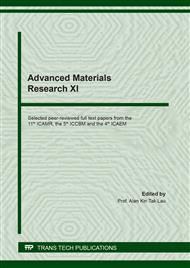[1]
J. Skelly, Decorative plating processes for common plastic resins: Resin selection as well as plastic part design is critical to matching the right finishing method with the intended application. Metal Finishing, Vol. 106 (2008), pp.61-65.
DOI: 10.1016/s0026-0576(08)80166-3
Google Scholar
[2]
M.V. Kulkarni, K. Elangovan, and K.H. Reddy, IMPROVEMENTS IN IMPACT RESISTANCE PROPERTY OF METAL PLATED ABS AND NYLON6. THERMOPLASTICS, (2012).
Google Scholar
[3]
M.V. Kulkarni, K. Elangovan, and R.K. Hemachandra, Effects of electroplating on the mechanical properties of injection molded thermoplastics. International Journal of Plastics Technology, Vol. 17 (2013), pp.163-170.
DOI: 10.1007/s12588-013-9056-6
Google Scholar
[4]
M. Khan, et al., Optimizing Surface Texture and Coating Thickness of Nickel Coated ABS-3D Parts. Materials Today: Proceedings, Vol. 5 (2018), pp.19011-19018.
DOI: 10.1016/j.matpr.2018.06.252
Google Scholar
[5]
O.D.S. Ferreira, A. Stevens, and C. Schrauwen, Quantitative comparison of adhesion in metal-to-plastic systems. Thin Solid Films, Vol. 517 (2009), pp.3070-3074.
DOI: 10.1016/j.tsf.2008.11.117
Google Scholar
[6]
G.X. Wang, et al., Process of direct copper plating on ABS plastics. Applied Surface Science, Vol. 253 (2006), pp.480-484.
DOI: 10.1016/j.apsusc.2005.12.106
Google Scholar
[7]
L. Di, et al., Effect of chemical etching on the Cu/Ni metallization of poly (ether ether ketone)/carbon fiber composites. Applied Surface Science, Vol. 257 (2011), pp.4272-4277.
DOI: 10.1016/j.apsusc.2010.12.035
Google Scholar
[8]
X. Tang, et al., A new palladium-free surface activation process for Ni electroless plating on ABS plastic. Materials Letters, Vol. 63 (2009), pp.840-842.
DOI: 10.1016/j.matlet.2009.01.006
Google Scholar
[9]
X. Tang, et al., A novel surface activation method for Ni/Au electroless plating of acrylonitrile–butadiene–styrene. Surface and Coatings Technology, Vol. 206 (2011), pp.1382-1388.
DOI: 10.1016/j.surfcoat.2011.08.064
Google Scholar
[10]
D. Chen, and Z. Kang, ABS plastic metallization through UV covalent grafting and layer-by-layer deposition. Surface and Coatings Technology, Vol. 328 (2017), pp.63-69.
DOI: 10.1016/j.surfcoat.2017.08.020
Google Scholar
[11]
Z. Yang, et al., Adhesion improvement of ABS resin to electroless copper by H2SO4–MnO2 colloid with ultrasound-assisted treatment. Journal of adhesion science and technology, Vol. 25 (2011), pp.1211-1221.
DOI: 10.1163/016942410x549915
Google Scholar
[12]
A. Roesner, et al., Laser assisted joining of plastic metal hybrids. Physics Procedia, Vol. 12 (2011), pp.370-377.
DOI: 10.1016/j.phpro.2011.03.146
Google Scholar


